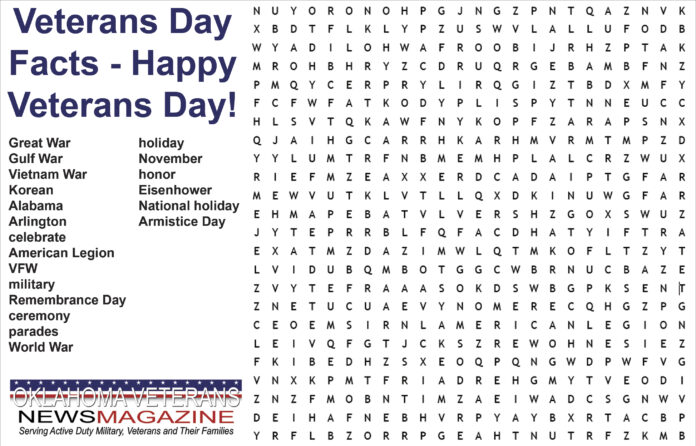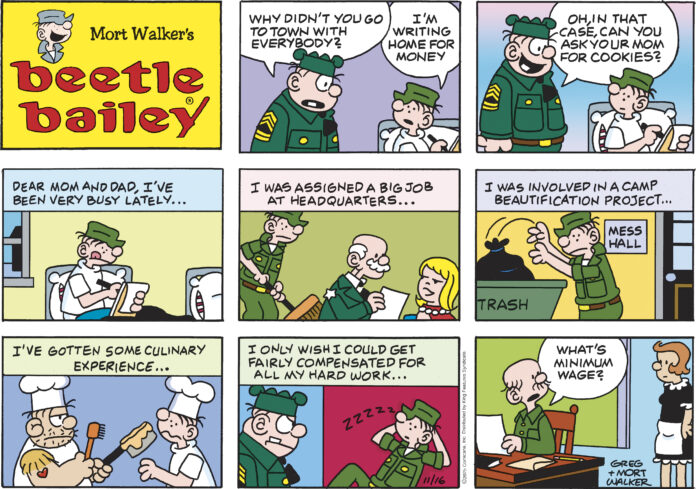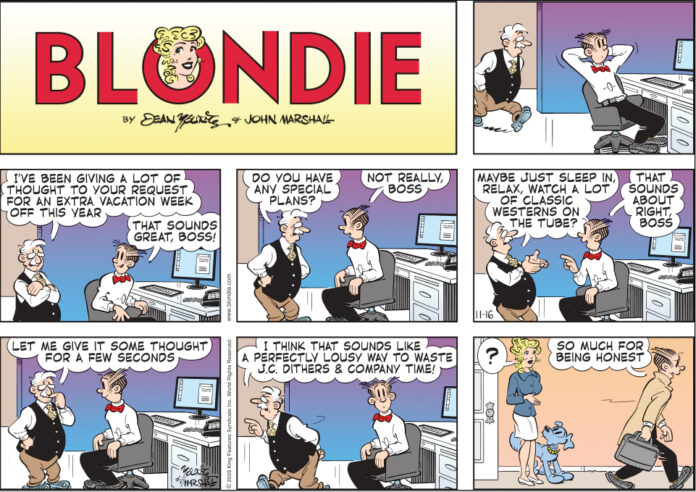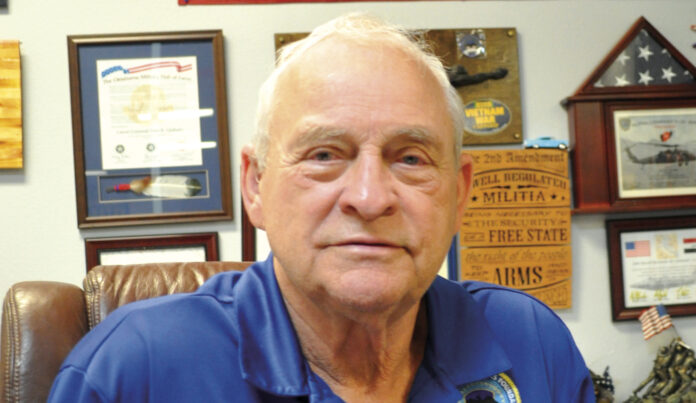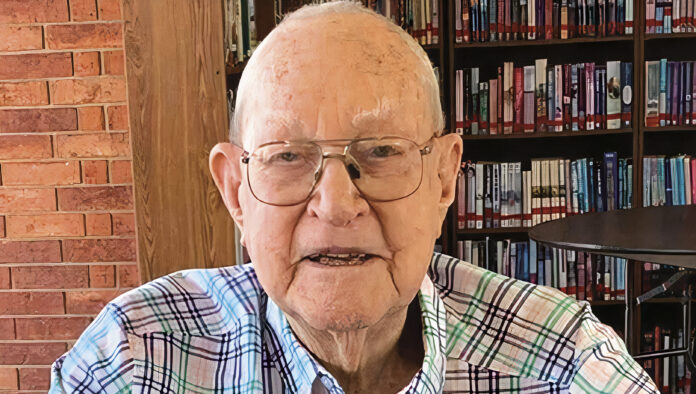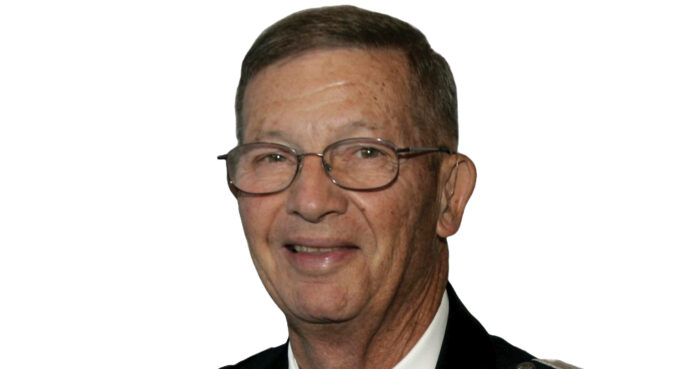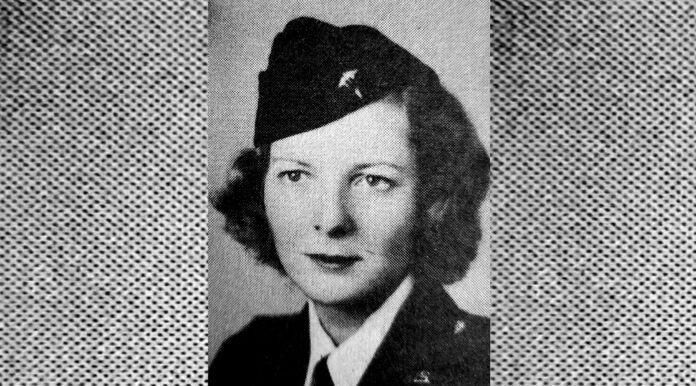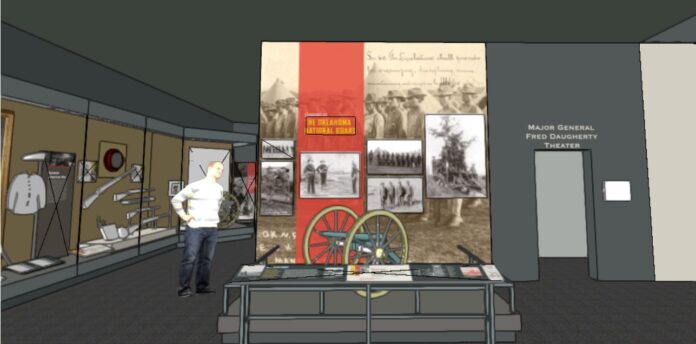Vets’ Fantastic, Free Roadside Attraction
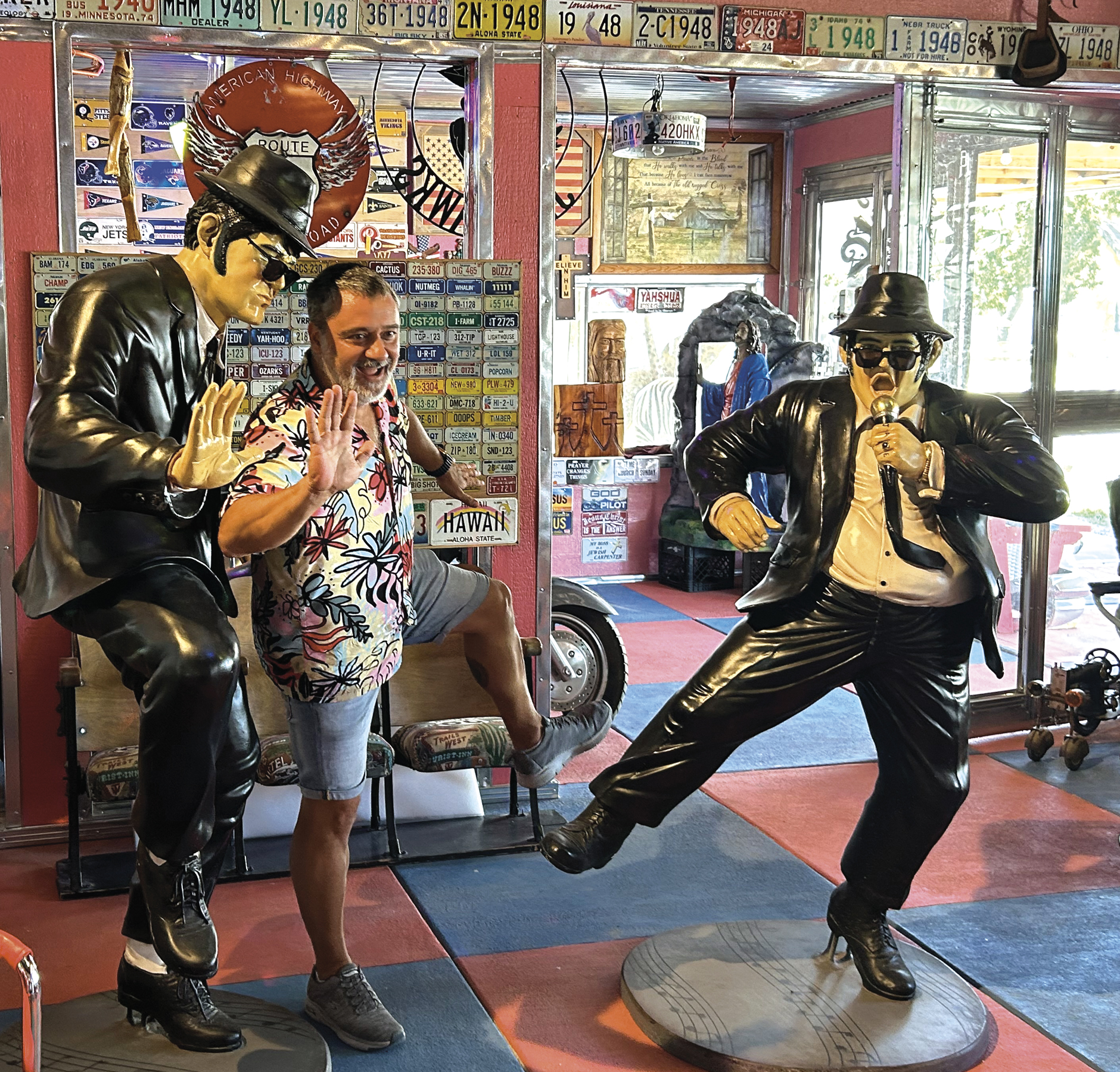
Wacky and wonderful, the CrosStar Flag and Tag Museum in Afton tugs tourists into a satisfyingly bizarre collection of oddities gathered by owner and operator Al Childs. Since opening in June 2022, the 150-foot by 150-foot museum has grown in variety and popularity. It’s eye candy on Route 66.
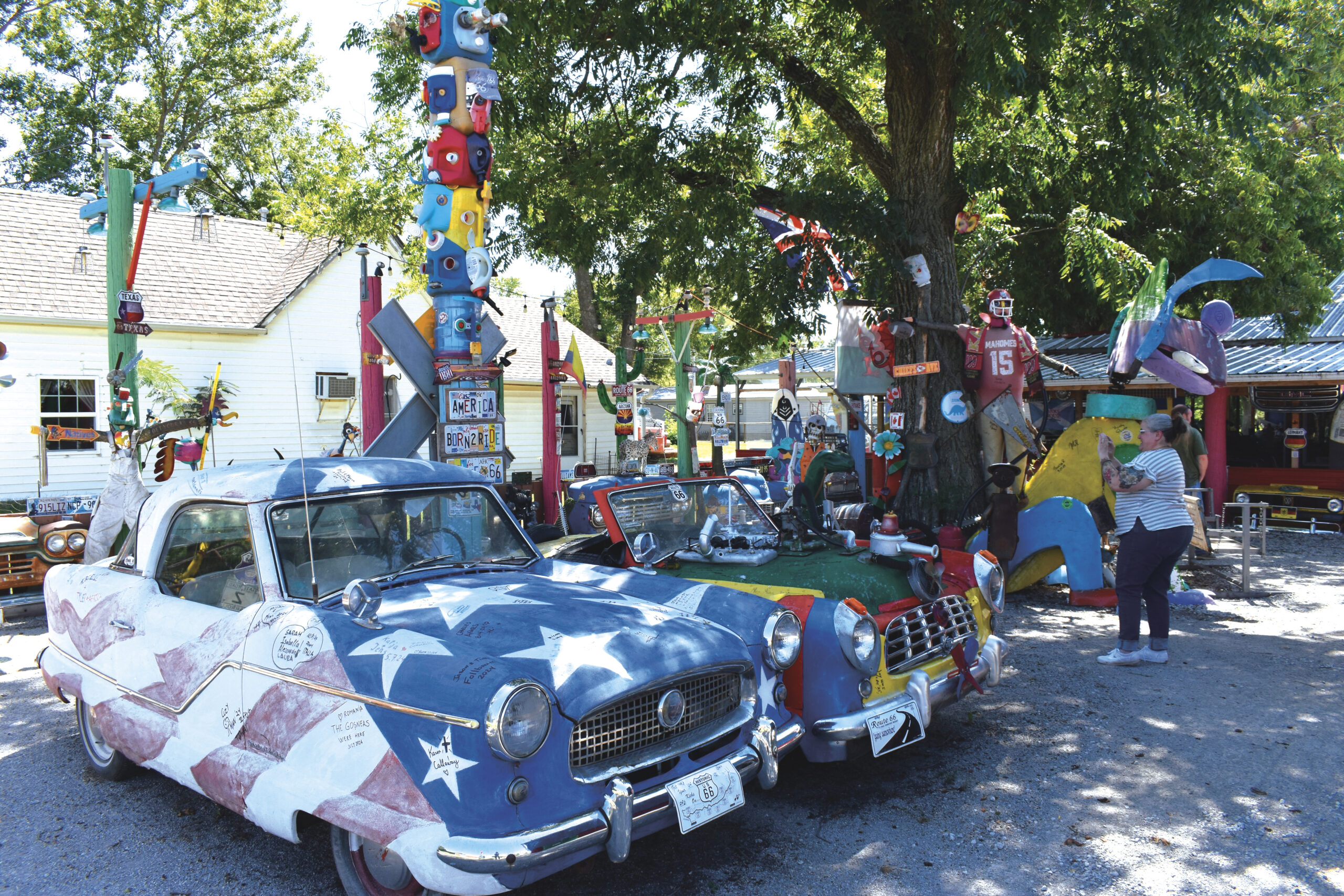
About 100 mostly international tourists drop in every day. A welcoming host, Childs, 77, happily escorts them through the building and grounds, explaining what they are seeing. “…one of my main sayings here is, ‘I guarantee you you’ll smile and laugh out loud or I’ll give your money back,’” he told two visitors. “You’re supposed to say, ‘Well, how much you charge? ‘Nothing!” is his answer.
There’s no entrance fee because, “I like Route 66 and there was some places I stopped at in 1976, it didn’t cost me a thing to see stuff like this, you know? You don’t gotta advertise on Route 66. Just stick something out front there!” he said, gesturing to the road. “They’ll come.”
After a family from Barcelona, Spain, arrived, the husband danced next to Jake and Elwood Blues Brothers statues while his daughter snapped photos. “There’s more stuff out there.You can touch, open doors, ring bells, smash buttons,” Childs encouraged.
There’s plenty to see: a Shoney Big Boy, original gas pumps, a 1951 Ford police car and 1959 Thunderbird, skeleton in a pick-up truck (joking, Childs tells visitors, “…that’s my ex-wife there. I dug her up. She wanted to go for a ride and I didn’t know she meant in the car”), totem poles, car hoods and grills for each of the eight Route 66 states and some for foreign nations, Elvis playing a guitar and much more.
Childs admits, “I wasn’t planning on getting this big when we started to do it. We were just going to have a little garage right there with my cars in it.” But he has too much energy to sit still. “VA doctors tell me I’m a 75-year-old in a 50-year-old body,” he said.
Childs and his partner, Jeanette, built most of the museum themselves. “We poured all this concrete by hand (concrete floor)…And she painted it all.” He constructed the metal overhang and porch, used a blow torch to cut and weld truck parts, and handled the carpentry.
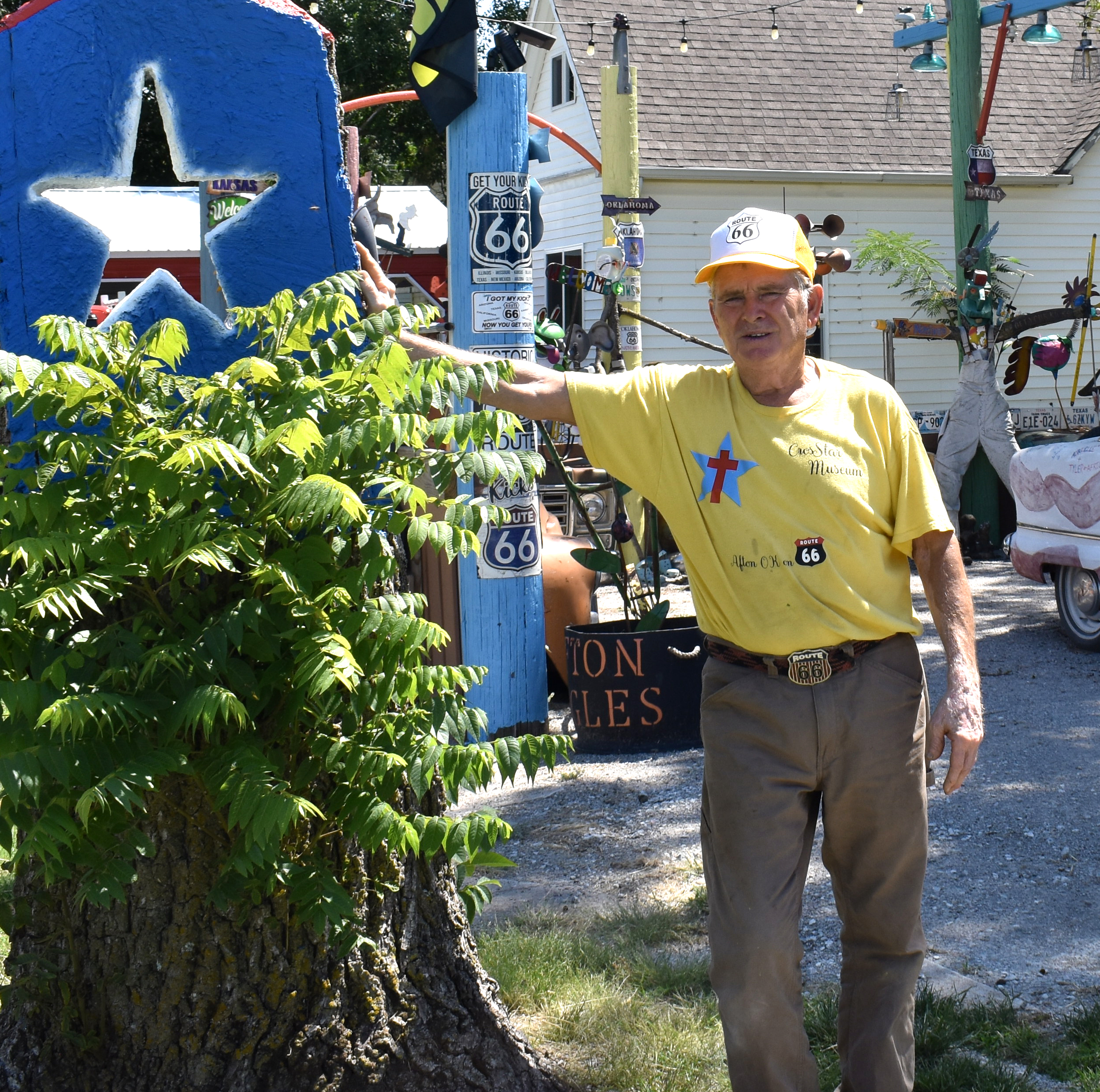
The museum is Childs’ therapy for post-traumatic stress disorder (PTSD) from a harrowing tour in Vietnam. He deployed as a U.S. Marine infantryman – 0311, grunt – with Echo Company, Second Battalion, Fifth Marines (2/5), 1st Marine Division from January – July 1968. His total time in service was August 1967-August 1969.
Childs said he arrived “right in the middle of…Tet Offensive…and I was in Phu Bai (Airfield) and then Hue City, and then we was up in the Bach Ma Mountains overlooking Khe Sanh…They was bombing, bombing everything… Well, probably in four days we lost 28 people and I was in a 10-man squad (during Khe Sahn battle). “My friend Joe Jordon was killed in action April 3rd 1968,” after being killed by a sniper.
During another battle, Childs recalled, “Two had died, I mean, the point man and the second man died. I was the fourth man back (in the platoon). And they set off one…a booby trap in the road or something. Well, this was in the jungle.”
Childs received two surface wounds but did not get a Purple Heart medal. (Author’s note: 2/5’s missions included search-and-destroy patrols, ambushes, and security for key routes, bridges and villages. The Khe Sanh battle occurred January to July 1968).
Malaria struck in July 1968, sending him to Japan for three months. He recovered in Okinawa. A doctor gave him a S3 profile and ‘no duty in a tropical zone.’ The illness came back three times.
After discharge in 1969, Childs battled PTSD and checked into two VA Centers. Doctors removed his prostate because of cancer. “I got a hundred percent for it (cancer), but I already had a hundred percent for Agent Orange and I think I had 70% for combat duty. I probably got 300% altogether, but you ain’t gonna get but a hundred percent no matter what,” he joked.
Childs drove heavy construction equipment and became a working superintendent for his brother. “I was in Kansas City for 45 years working in construction and then I retired and that’s when I decided wanted me a museum.”
Glen and Misty Posey from Decatur, Alabama, visit. Glen said, “we started off heading west for California. Got to Flagstaff, she got sick. So, we’re riding it backwards all the way back to Chicago.” They were celebrating their 31st wedding anniversary.
The name “CrosStar” comes from his Vietnam memories, where he often saw buildings marked with red stars and crosses. His favorite piece at the museum is a blue painted tree stump with a star cut out and a red cross on top.
Austin Hanes, manager of the “Nowhere on Route 66” restaurant in town, said, “It’s good for business. I like sending people that way and it’s a neat piece of ‘66.”’ Linda Tipton, a home town resident, agreed. “I believe when they stop there…it brings business (here). I think it’s a good thing for our town.”
Rhys Martin, President of the Oklahoma Route 66 Association, added that, “It takes a passionate person with a dream to make these (Route 66) attractions a reality…anyone that stops to look around and talks to Al gets an experience they will never forget.”
The museum is at 103 S. Central Ave (Route 66), is open every day and during the summer, “open until we close.” • story by Lt Col Richard Stephens, Jr., USAFR, Ret.
Oklahoma Vet Keeps On Serving
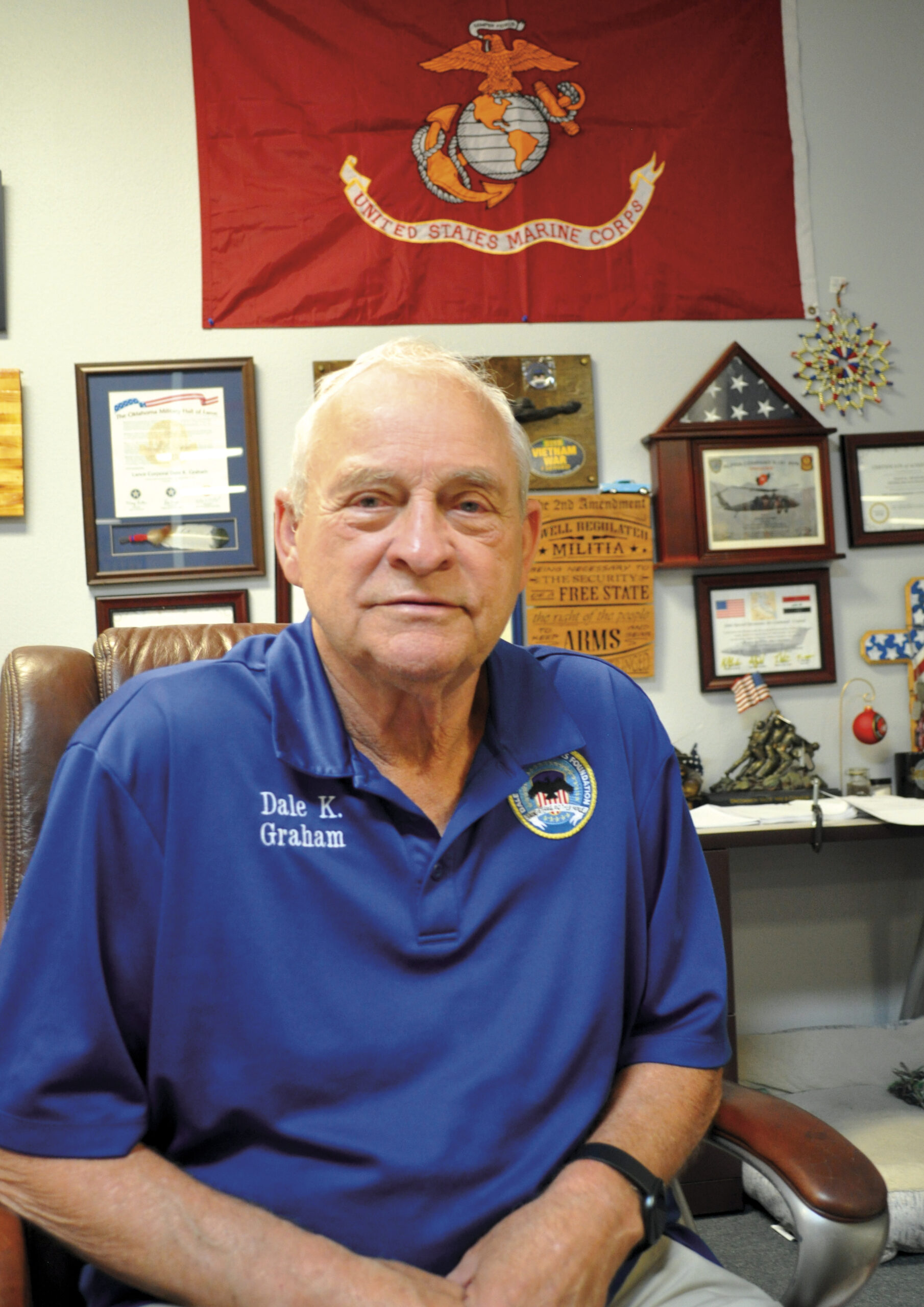
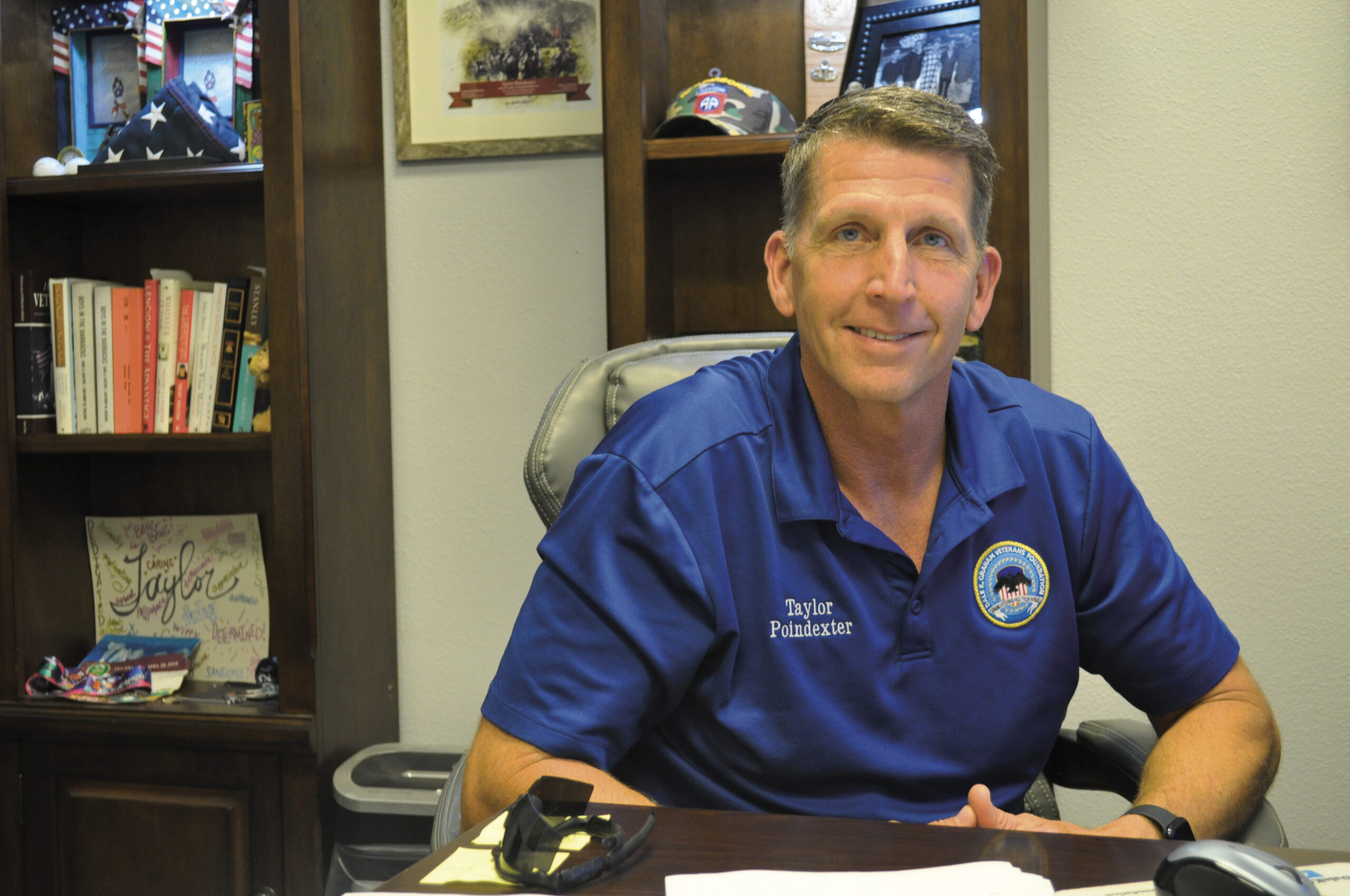
All 77 Oklahoma Counties.
All 50 states.
Numerous foreign countries.
The geographic reach of Dale K. Graham Veterans Foundation is staggering.
But even moreso, the impact for veterans, their families and generations to come is incalculable.
The operation has grown beyond even Graham’s expectation but the process is always a familiar one.
A friendly voice on the phone leads to a visit to the Norman office where a hot cup of coffee and some of the nicest people you’ll ever meet are waiting to thank you for your service, pull you up a chair and show you how to get the benefits you’ve earned for you and your family.
At the heart of it all is Dale Graham, who served in the Marines.
The Veteran’s Administration ranks Graham’s foundation as the eighth-leading organization in the nation in terms of the amount of money procured for veterans and their surviving spouses.
He says service members who have worked with the foundation are currently receiving $900 million per year in benefits.
“In reality it’s double or triple that,” Graham said, noting those numbers only count the last eight years of the organization’s existence, not the 20 that preceded it. “It’s worked out real good.”
More than half of those who seek out the foundation’s assistance travel from out of state, he says.
“The men and women who served got the short end of the stick.”
Last fall, Graham welcomed a service member who flew in from Vietnam. Another from China, another from Dubai, another from Greece.
England, Australia, Africa, the list goes on and on.
“I’ve never seen anything like it,” Graham said. “But we’re winning.”
Graham still volunteers his time but the foundation pays a small army of staff that is amazing to watch in action. And there’s another dedicated group of volunteers that’s the backbone of what the foundation accomplishes.
“When you help somebody else it helps you,” he said.
It’s a lesson he learned later rather than sooner.
He turned to alcohol to cope with the PTSD he brought back with him after serving in Vietnam. He says it dotted almost 30 years of his life.
“It was the only way I could deal with life. Or I thought it was,” he said. “But we got all that past and now we just do what we can do to change lives.”
Changing lives involves helping navigate a seemingly unfair maze of paperwork to service-connect disabilities veterans thought just went hand in hand with serving their country.
“Everything we’re doing down here is working,” Graham said.
The stories that come through the front door are devastating; service widows losing their homes due to rising inflation, veterans living out on the street who don’t want to ask for help.
“I had one couple come in and I did his papers and he told me ‘next month I get my medicine,’” Graham remembers. “He told me they took turns getting their heart medicines every other month to keep costs down and they hoped nothing else ever happens.”
“Him and his wife were living on $1,200 a month. When I got through with him he was getting $4,000 a month from the VA. It’s the richest he’s ever been.”
The times Graham is able to get a service member 100-percent service connected they are able to receive free medical insurance for the spouse and the kids.
“What we’re doing today I think is wonderful,” he said.
More than a decade ago, Graham was invited to Harvard to speak about how he was helping returning veterans.
He’s an expert, but to some service members he’s a savior.
Taylor Poindexter agrees. As the foundation’s Chief Executive Officer, Poindexter helps the foundation keep moving forward and track its reach.
“The impact we are having is unmeasurable,” Poindexter said. “Not only are we improving the quality of life for our veterans but we’re actually saving some of their lives.”
Nearly 30 years ago, the Dale K. Graham Veterans Foundation was founded by Graham and Rhonda Reynolds and is dedicated to serving veterans and their families.
Recognizing the challenges veterans face in accessing their entitled benefits, the founders were driven by a deep commitment to fight for those who have served our country.
Since its inception, the Foundation has provided essential services including accredited VA claims assistance, transportation, financial aid, and referral management, ensuring veterans receive the full range of support they deserve.
The Foundation has helped more than 50,000 veterans and their families.
“Not only does it change quality of life, it changes quality of opportunity,” Poindexter said. “We are making a difference and the difference we are making we’ll probably never know. But the only way we truly know is when you and I as veterans get service connected we know how it affects our lives.” •
story and photos by Bobby Anderson, staff writer
Service, Loyalty, Honor, Faith and Compassion
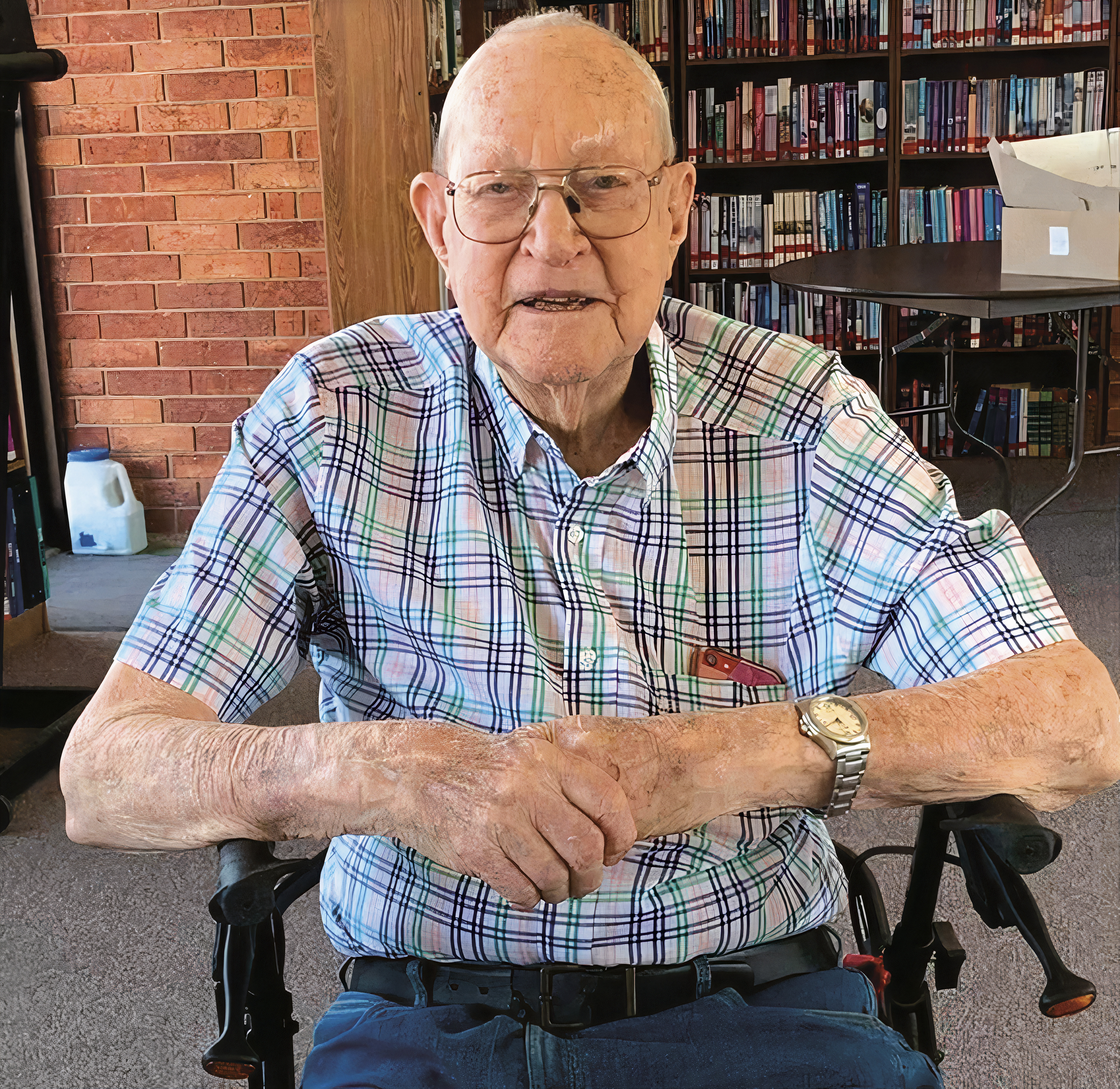
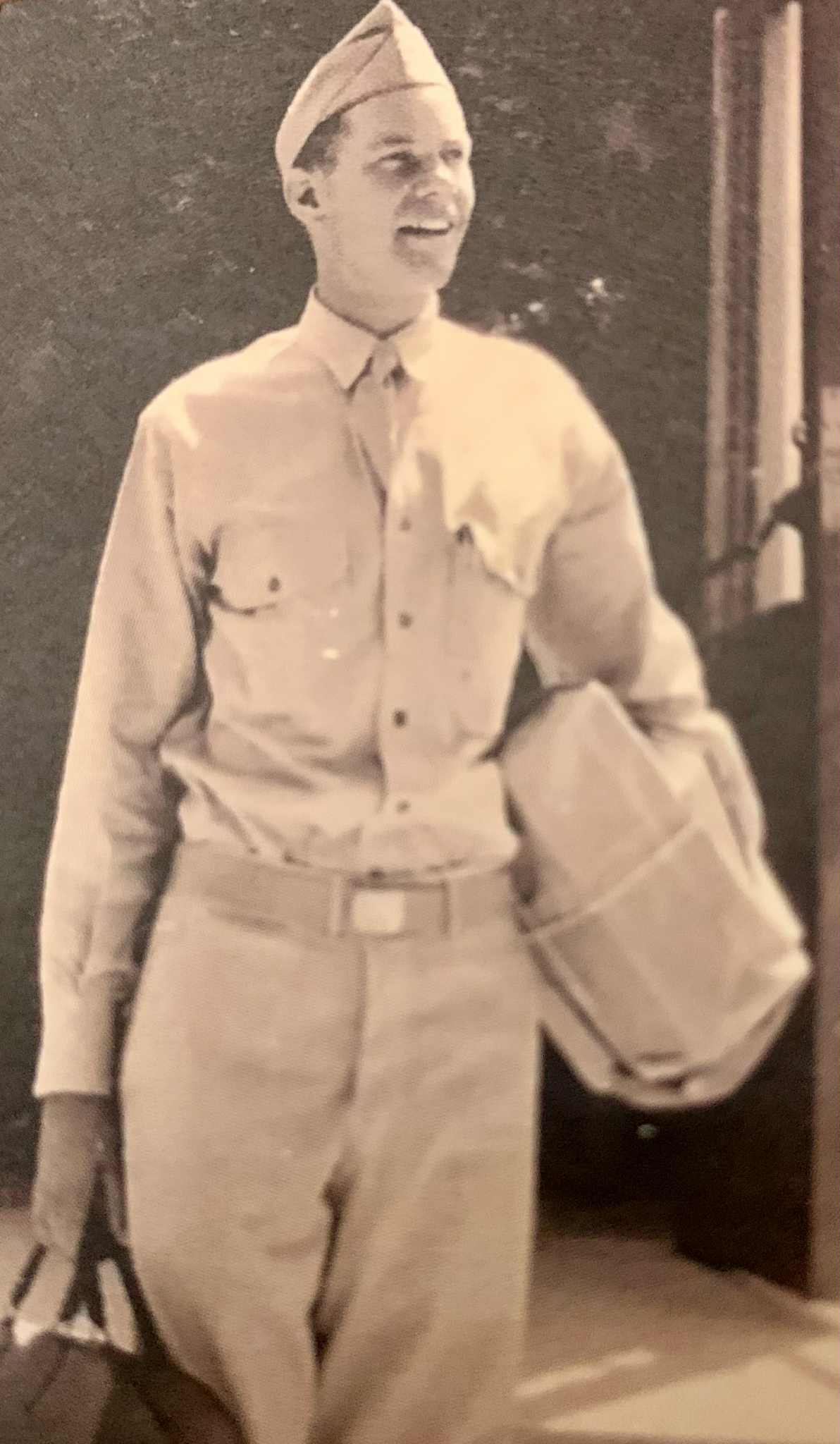
Jerrold “Jerry” F. Hooker’s life is a shining example of service, loyalty, and honor. Born on August 21, 1919, on his Uncle Floyd’s farm in Colorado, Jerry grew up during a time of great change in America. He spent his first 22 years in Colorado, later living 4 years in Egypt, and eventually calling Oklahoma home for the past 80 years.
Jerry’s childhood was marked by both challenges and determination. At just 7 years old in 1926, he sustained a traumatic amputation of four toes on his left foot when a hay derrick fell, yet even then he carried out his chores-hauling water in canvas bags on horseback to the men in the hay fields. By 1938, he graduated high school at age 18, having worked hard to save enough money to buy his very first car: a Model “A” Ford for $75.
When World War II began, Jerry was just 22 years old. In April 1942, he enlisted in the Army at Fort Logan, Colorado, where his typing ability led to his first assignment as a medical corps clerk typist. He completed 12 weeks of basic training at Camp Bowie in Brownwood, Texas, followed by further training at Fort Moultrie on Sullivan’s Island, South Carolina. From there, he traveled to Camp Kilmer, New Jersey, the Army’s largest processing center for troops shipping overseas.
On September 21, 1942, Jerry boarded the HMS Aquitania in Staten Island, New York, beginning a 40-day journey across the Atlantic and around the coast of Africa. Sailing in a zig-zag pattern to avoid German U-boats, the ship ultimately reached the Port of Suez. By October 31, 1942, Jerry had traveled 16,700 miles by sea to set up a military hospital in the desert outside Cairo, Egypt.
There, on Armistice Day-November 11, 1942, the 38th General Hospital opened its doors to provide care for Allied forces wounded in the North African campaign. Jerry’s service spanned multiple roles: he first worked as an orthopedic clerk, then was promoted to Corporal, before becoming Supply Sergeant. In this position, he managed medical supplies and inventory for 64 doctors, 105 nurses, and 500 enlisted men. His duties eventually expanded as General Supply Sergeant and later Staff Sergeant, where he not only managed uniforms and equipment but was entrusted with sole access to locked medical supplies. His leadership and integrity earned the deep trust of his superiors and fellow soldiers alike.
Jerry remained overseas until 1945, serving in the Middle East and North Africa, and he was later called back during the Korean War in 1951, serving for one year at Fort Sill in Lawton, Oklahoma.
After his military service, Jerry began his civilian life in Oklahoma. In 1945, he moved to Hitchcock, where he married Grace Spaeth the following year. They shared 30 years of marriage until her passing from cancer in 1976. Jerry built a meaningful life in Hitchcock, where he ran a grocery and general store, as well as the Whistle Stop Restaurant. He served as Mayor for 18 years, taught Sunday school at the Methodist Church for 22 years, and managed the local COOP Grain Elevator for 12 years.
In 1978, Jerry moved to Okeene, Oklahoma, where he married Emma Osmus, with whom he shared 32 years of marriage until her passing in 2010. In Okeene, he worked as assistant manager at the COOP Grain Elevator, served on the Blaine County Excise Board, and was active in the Masonic Lodge, achieving Master Mason after 50 years of service. He was also a devoted member of the Okeene Methodist Church.
In 2012, at the age of 93, Jerry moved into the Independent Living Facility at Fairview Fellowship Home, where he has continued to inspire those around him with his humility, wisdom, and steady faith.
Through each chapter of his journey-whether on the battlefield, in service to his community, or as a family man-Jerry demonstrated loyalty, leadership, and an unwavering dedication to others. His story is one of quiet strength, resilience, and devotion that has spanned more than a century.
And now, we celebrate not only his remarkable life of service but also a milestone that few in history will ever reach.
On August 21, 2025, Jerrold “Jerry” F. Hooker celebrated his 106th birthday.
A true American hero, a man of faith, loyalty, and compassion – Jerry reminds us that a life dedicated to service is a life well lived. •
story by Latisha King
America’s Last Six MiG Air Ace
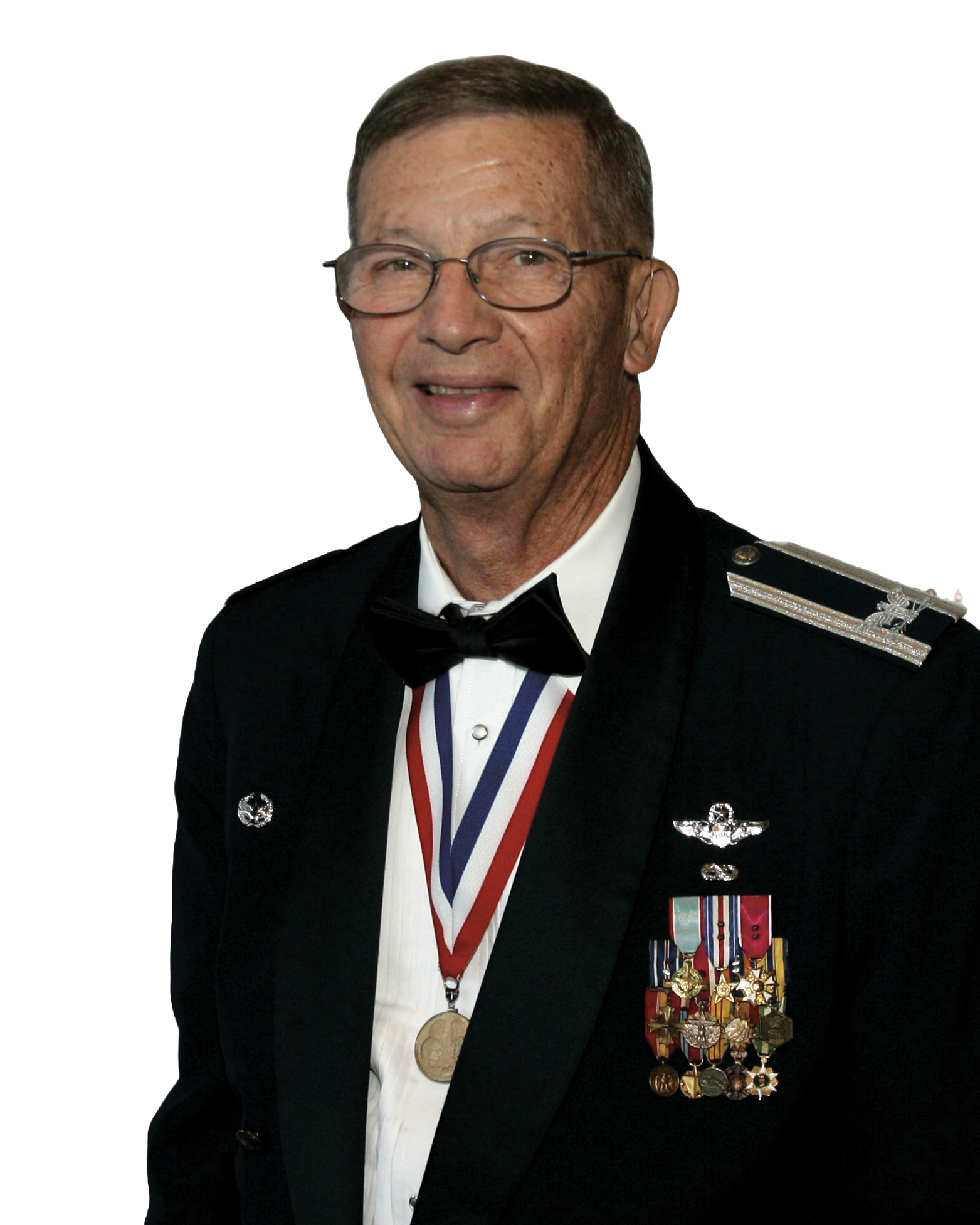
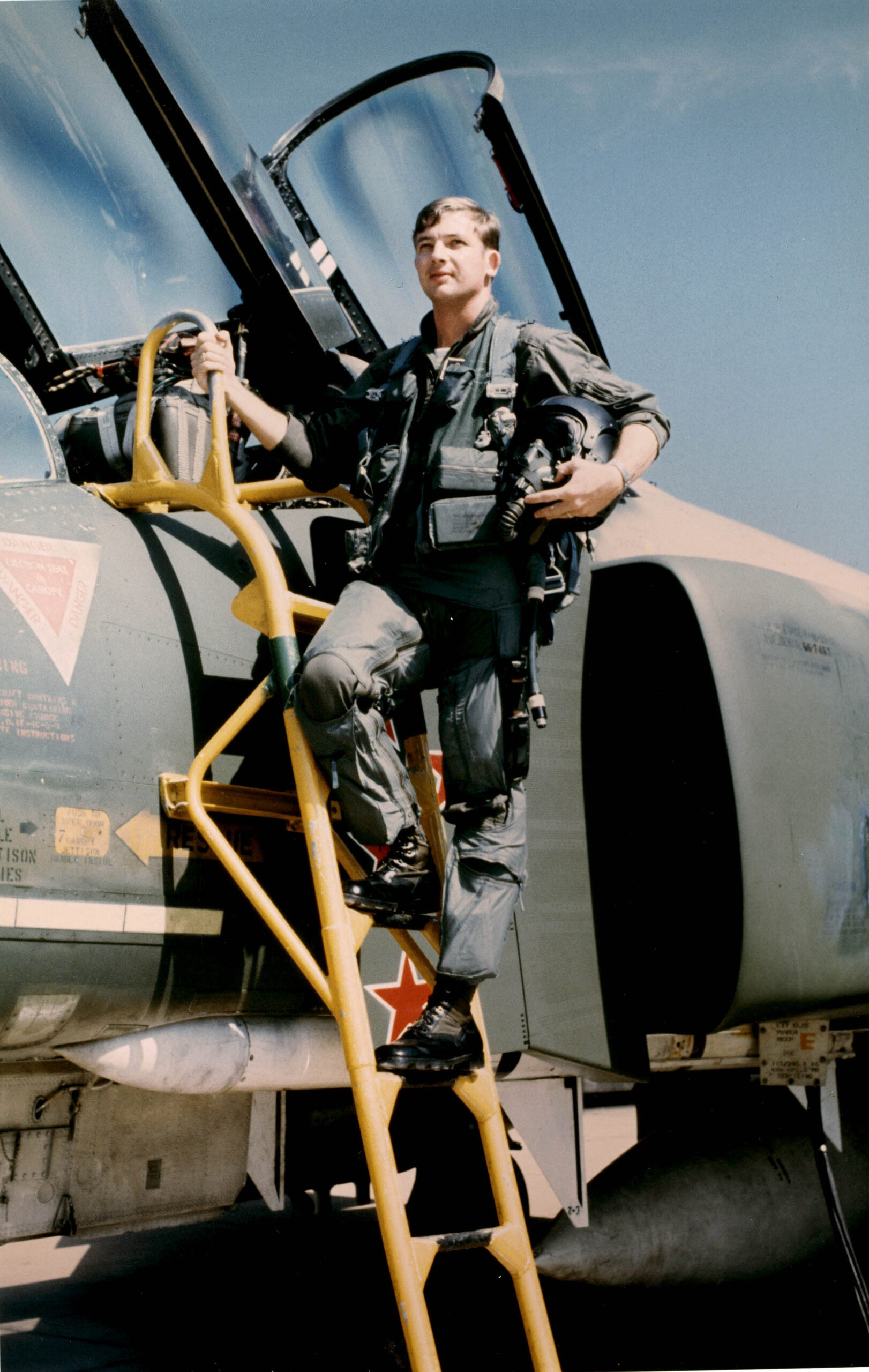
Retired U.S. Air Force Col. Charles “Chuck” DeBellevue, now living in Edmond, is the top Vietnam War fighter ace, with six MiG kills, from the last American aerial combat era to produce aces.
“The U.S. Air Force credited us Weapons System Officers (WSOs) with equal credit for MiG kills in Vietnam because we were essential in the F-4 Phantom II weapons and sensor team with the pilot and the other fighters in our flights,” DeBellevue said in an interview. “The aircraft was designed around advanced radar and air-to-air missiles, and as the WSO in the back seat, my vigilance was critical to the team for operating this complex system to shoot down MiGs.”
The McDonnell Douglas F-4 Phantom II fighter, a high-altitude interceptor, was developed with the assumption that long-range, radar-guided missiles would render classic dogfighting obsolete. The supersonic fighter relied entirely on its missile armament and fire-control radar system to engage targets. This system was far too complex for a single pilot to manage while also flying the aircraft in combat, especially while maintaining mission communications and navigation duties.
The WSO was responsible for operating the aircraft’s powerful radar, tracking enemy aircraft, to help direct the pilot, while also managing targeting and the use of weapons. The WSO managed the firing of the F-4’s sophisticated AIM-7 Sparrow and AIM-9 Sidewinder air-to-air missiles.
“My role in shooting down North Vietnamese Mikoyan-Gurevich MiG-19s and MiG-21s was to assess situational awareness of the whole tactical battlefield in the sky,” DeBellevue said. “This included what was being fired at us from the ground to shoot us down. We fought in the most heavily defended airspace in the world, except around Moscow during the Vietnam War. Whenever we flew close to Hanoi, we became the target, not the MiGs we were engaging.”
WSOs were also trained in ground attack, reconnaissance, electronic warfare, and forward air control.
Although not designed for extensive monitoring of ground threats, the F-4 proved to be a special aircraft in missions to shoot down MiGs because it used the top-secret Combat Tree system, installed on a select few F-4s. This equipment played a pivotal role in their missions as air crews gained a decisive advantage over Vietnamese Air Force MiGs.
Combat Tree was a modified Identification Friend or Foe (IFF) interrogator. The Vietnamese used Soviet-made SRO-2 IFF transponders on their MiGs. The enemy ground-controlled interception stations and Surface-to-Air missile (SAMs) sites used the transponder signal to distinguish friendly aircraft from US attackers.
“We used the Combat Tree our technical geniuses came up with to gain the tactical advantage. By ‘interrogating’ the enemy’s IFF system, we could receive a signal from the MiG’s transponder,” DeBellevue said. “This gave the F-4 crew a positive, long-range identification of a MiG, even in the ‘look-down’ clutter of my normal radar screen.”
The Combat Tree employed a passive detection method, unlike a normal radar “lock,” allowing it to passively detect and target MiGs from beyond visual range without alerting the enemy. This allowed the American F-4 crews to maneuver into an optimal position for an ambush.
On May 10, 1972, DeBellevue, flying with pilot Captain Steve Ritchie on a MiG Combat Air Patrol (MiGCAP), was vectored by command and control aircraft toward a flight of MiG-21s. Combat Tree allowed DeBellevue to identify and track one of the MiG-21s from beyond visual range.
With the Combat Tree providing a confirmed, long-range target, Ritchie strategically maneuvered their F-4 into an optimal firing position. DeBellevue launched two AIM-7 Sparrow missiles, scoring their first kill. This strategic thinking and quick decision-making in the heat of battle, amidst the intense pressure, are what made the air crew successful.
On July 8, 1972, while Captain Ritchie was flying a MiG sweep in an F-4E, they were alerted to two MiG-21s.
The men tracked the lead MiG and then quickly confirmed the second, trailing MiG, which was a known tactic for ambushing American fighters.
Ritchie to set up a reversal maneuver without the MiGs detecting them. DeBellevue fired two AIM-7 Sparrows at the trailing MiG, one of which hit the engine for the second kill. A quick maneuver onto the lead MiG and a final Sparrow secured the third kill, all within two minutes.
On August 28, 1972, DeBellevue and Captain Ritchie were protecting a Linebacker strike mission. When they encountered a single MiG-21 at high altitude, the crew used Combat Tree to acquire a radar lock that was head-on, giving them a critical ‘first-look’ advantage. DeBellevue fired four AIM-7 missiles, with the fourth finally impacting the MiG.
DeBellevue’s last two kills, making him an ace and the highest scoring ace of the war, took place on September 9, 1972. Ace is defined as having five or more confirmed aerial victories. Flying with his new pilot, Captain John Madden, on a MiGCAP flight near Phuc Yen Air Base in North Vietnam, they were engaged by two MiG-19s.
“The strength of our partnership and the teamwork between us, our mutual reliance on each other, was evident in this final mission,” DeBellevue said.
Supplying his pilot with Combat Tree data, Madden was able to perform a “slicing, low-speed yo-yo” maneuver to get behind the first MiG-19. DeBellevue then guided a heat-seeking AIM-9 Sidewinder to detonate near the first MiG. A quick switch to the second MiG allowed them to launch another AIM-9, which hit that aircraft’s tail. The two kills were scored within minutes of each other.
“All of this dogfight action is what the public wants to hear about. But first, we had to survive the battlefield below us to hunt and kill MiGs,” DeBellevue said.
The F-4 Phantom II WSOs faced a sophisticated and dense integrated air defense system primarily supplied and developed by the Soviet Union. The WSO used the F-4’s electronics to detect and counter these threats.
This threat included SAMs, radar-guided, high-altitude missiles that could reach up to 90,000 feet. WSOs were responsible for operating electronic countermeasures to give the pilot crucial information about the missile’s launch and flight path. By acting on this info to make evasive maneuvers, they countered the SAM threat.
Another ground-based missile threat WSOs monitored was SA-7 “Grail” (Strela-2), a shoulder-fired, heat-seeking missile. The WSO would often be the first to spot the launch smoke trail or receive electronic warnings. He then directed the pilot to deploy flares to confuse the missile’s heat seeker, thereby increasing the aircraft’s chances of survival.
North Vietnamese Anti-Aircraft Artillery’s (AAA) multi-layered threat was responsible for more American aircraft losses than any other enemy weapon system. The enemy employed a wide range of Soviet and Chinese-supplied anti-aircraft guns, from heavy machine guns to giant cannons.
The WSOs employed countermeasures for all this battlefield danger. In addition to using Electronic Countermeasures pods to jam larger radar-guided guns, the WSO would monitor and call out AAA activity based on visual cues and radar indications. This allowed the pilot to adjust flight paths and perform evasive actions to mitigate the risk of being hit.
Observing outside the cockpit while also focused on their electronic warfare responsibilities, the WSO focused on the broader threat beyond just the immediate visual field. This vigilance was crucial for the survival of both crew members.
“It was my job to keep us alive by constantly scanning for enemy threats on the ground and other planes approaching while the pilot flew the aircraft,” DeBellevue said. “This experience, while I worked with two different pilots during my time above Hanoi and North Vietnam, made me a new type of ace in a new kind of war.”
The F-4’s two-person pilot-WSO team revolutionized air combat by proving that a dual-crew design could effectively manage the workload of a complex, multi-role fighter. Pilot Ritchie and WSO DeBellevue of the 555th Tactical Fighter Squadron (“Triple Nickel”) were the USAF’s only aces of the Vietnam War. •
story and photos by Darl DeVault, contributing editor
Loudermilk Touts Second Half Life Reinvention in Book

Retirement isn’t what it used to be. In fact, according to entrepreneur and speaker Bob Loudermilk, traditional retirement as we know it is obsolete.
His new book, “Never Retire: Reinvent Yourself for Life’s Second Half,” invites readers to reject the old notion of slowing down and instead embrace life’s second half as their most meaningful, adventurous, and impactful season yet.
For generations, people have been taught that the pinnacle of success is reaching the day you stop working. But Loudermilk argues that the traditional script is broken. Longer lifespans, shifting economies, and a universal longing for purpose mean that “checking out” at 65 is not only unrealistic for many-it can also be harmful.
“Traditional retirement too often leads to boredom, loss of identity, and even decline,” Loudermilk says. “But what if these years could actually become your most vibrant, productive, and meaningful chapter yet?”
“Never Retire” shows readers how to trade the myth of retirement for the joy of reinvention. With a blend of powerful storytelling, practical strategies, and research-backed insights, Loudermilk paints a picture of what’s possible when people bring the same creativity, grit, and courage that shaped their first half of life into the second.
Readers will meet people who refused to fade away-entrepreneurs who started businesses later in life, artists who created masterpieces in their seventies and eighties, and everyday men and women who found new callings that gave them a fresh sense of joy and contribution.
“Many people, after retiring from an active career, loose their vitality quickly if they don’t remain active,” Loudermilk said. “Parking in front of the television and not engaging in social interaction is a recipe for rapid decline. My slogan is, don’t retire FROM something, retire TO something. The book is all about mindset and strategies to make your second half of life some of your best years.”
Loudermilk said this is not a book of theory. It is a practical roadmap for designing a second half filled with purpose, vitality, and lasting impact. Each chapter helps readers think differently, dream bigger, and take meaningful action to create a future worth living into. “It’s different from anything else on the shelf, and I think it will resonate with readers who are 50+,” he said.”
Loudermilk said the release of “Never Retire” is incredibly timely. With approximately 10,000 baby boomers turning 65 every day in America, this cultural moment demands a new way of thinking.
Loudermilk believes now is the time to dismantle outdated views of aging and replace them with a vision of possibility.
“The message is clear: the second half of life is not about retreat-it is about reinvention,” he said.
Dave Sheets of BelieversBookServices praised Loudermilk’s book.
“Bob Loudermilk doesn’t just challenge the idea of retirement-he dismantles it with wisdom and hope,” he said. “This book is a must-read for anyone approaching life’s ‘next act.’”
Loudermilk brings decades of entrepreneurial and mentoring experience to this message. He is also the cofounder of the Second Half Expo, the annual event that equips thousands of adults 50+ to thrive with resources, inspiration, and community. His passion for helping others live boldly in their later years flows through every page of the book.
The official launch celebration for “Never Retire” will take place on Saturday, October 18, 2025, at the Second Half Expo inside the National Cowboy & Western Heritage Museum in Oklahoma City.
Attendees will hear Loudermilk speak, connect with others who share the vision, and join in the book launch party at 10 a.m., marking the beginning of a movement. Details for the Expo are at www.SecondHalfExpo.com
Loudermilk said his message to readers is contained in this declaration: “I am not done yet. There is more in me than I realized. I have a legacy that I will be leaving, and I am creating my legacy right now. There is more ahead.”
He concluded “The closing chapter is about living by an ultimate operating system, which is faith. It is about living with an expectation that you have a purpose and that your life matters.”
Readers can download free sample chapters of the book or order their copy today at https://secondhalfexpo.com/never-retire/ . • story by Van Mitchell, staff writer
A Life of Courage and Compassion: Remembering Second Lieutenant Geraldine Crouch
Special to OKVN
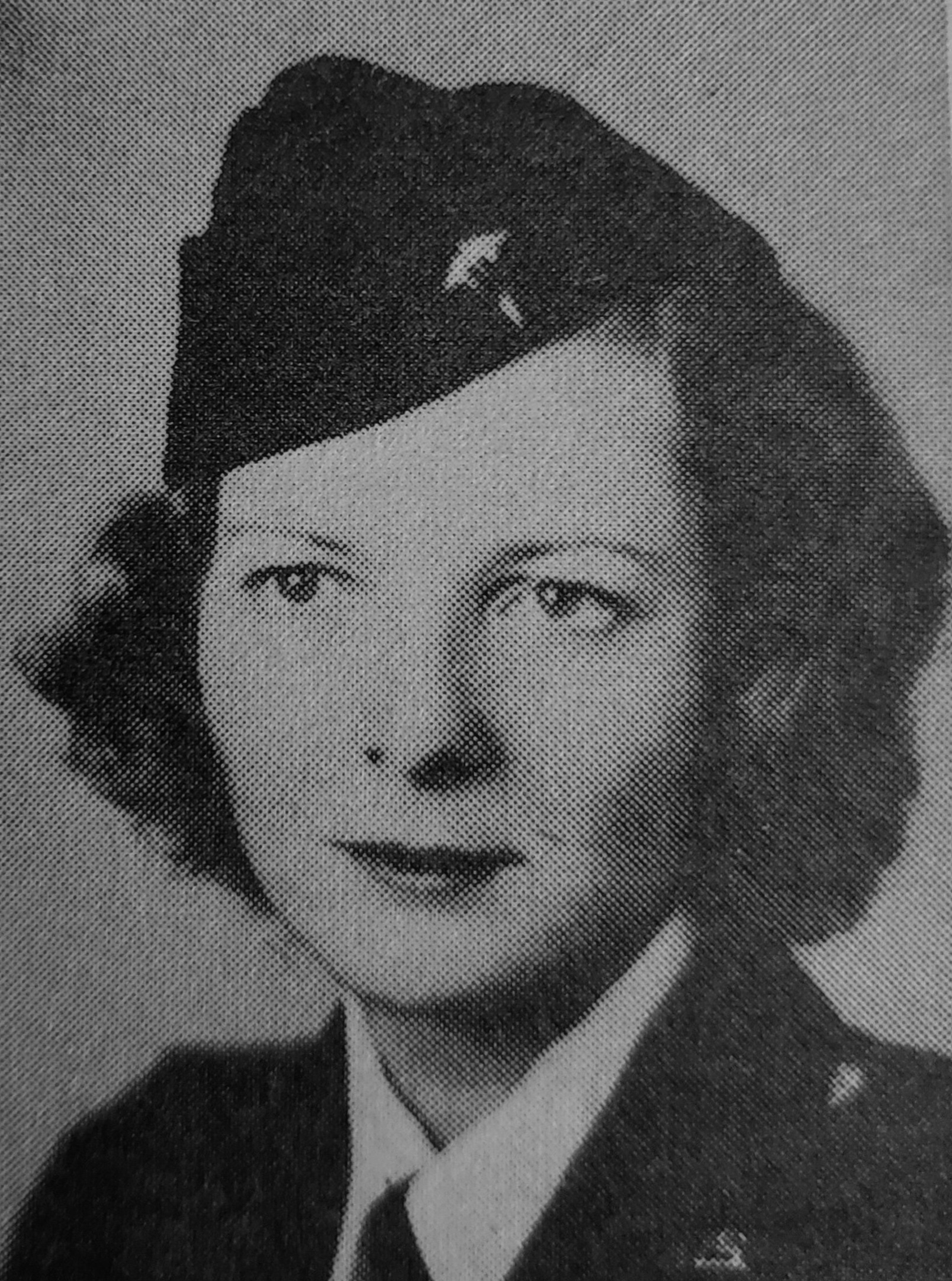
(Courtesy of Ben Jacobs)
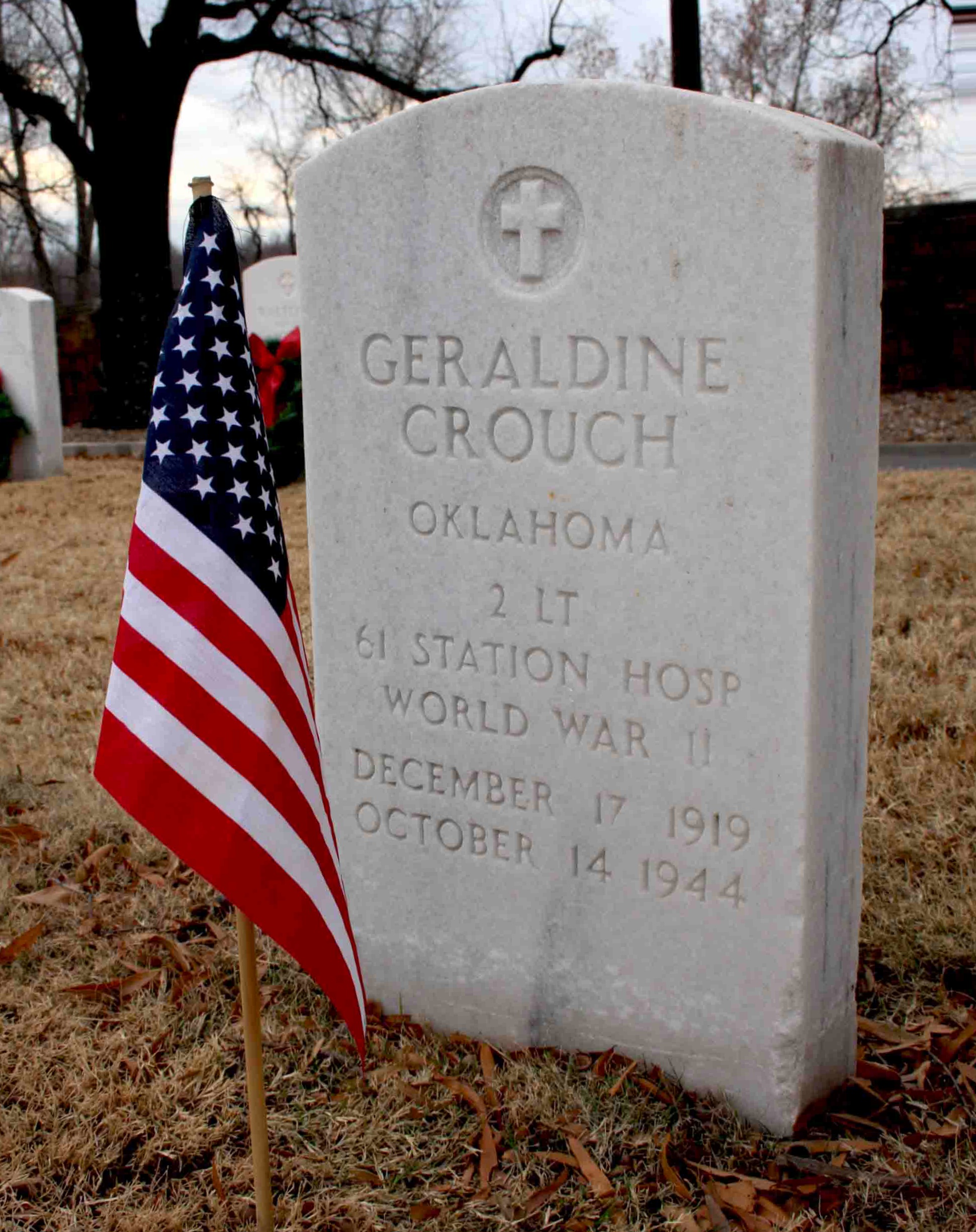
During World War II, tyranny and devastation swept over continents, and the very foundations of our freedom stood in peril. In the face of such danger, communities across Oklahoma did not hesitate. From the bustling streets of Tulsa to the wide-open fields of the Red River Valley, men and women from every corner of the state stepped forward-answering the call when it mattered most. They asked for no recognition or reward, yet history will forever remember them as heroes. Among the courageous women who left Oklahoma but never came home was Second Lieutenant Geraldine Crouch.
Born on December 17, 1919, in McAlester, Geraldine was the cherished daughter of Eugene and Virgie Crouch. She grew up in a close-knit community and shared unforgettable memories with her three sisters and four brothers. From a very young age, Geraldine showed a deep care for those around her-a compassion that would define her life. Her childhood in the heart of McAlester was filled with joy and laughter, but in 1931, her mother passed away. Geraldine was only 11 years old, and that sudden loss left a scar that never fully healed.
Geraldine attended McAlester High School, where she was loved by classmates and teachers alike. Her thoughtfulness and natural empathy were evident to all who knew her. Inspired by a desire to help others, she pursued nurse training at University Hospital in Oklahoma City. After her studies, she returned home and became an assistant nurse at the McAlester Clinic, where her care and dedication earned the admiration of colleagues and patients.
When World War II spread across the globe, Geraldine felt a profound sense of duty and the need to heal the wounds of war. In 1942, she joined the U.S. Army Nurse Corps, serving with the 61st Station Hospital, and was initially stationed in Texas. A year later, she was deployed to North Africa, tending wounded soldiers with tireless devotion. She later served in Sicily and the Italian Campaign, where she continued her mission under grueling conditions, always bringing comfort and relief to those in the most desperate situations.
Tragically, on October 14, 1944, Geraldine was aboard a B-24 aircraft flying over Italy when disaster struck. The plane crashed into a hill near Rocchetta Sant’Antonio in Foggia, killing her instantly. She was only 24 years old, with so much life ahead of her, and so much yet to give.
Back in McAlester, news of her death sent shockwaves through the entire community, leaving her father, siblings, and neighbors heartbroken. The thought of never again seeing her smile or hearing her voice was unbearable. Her father passed away in 1961, and one by one, her siblings also died, carrying with them the lasting memory of Geraldine’s generosity and humanity.
Today, Geraldine rests at Fort Smith National Cemetery in Arkansas, among countless American heroes who gave their lives to make the world a better place. The cemetery is a site of quiet reflection, where her service is honored in reverent silence. Her headstone stands as an eternal reminder of a life, a story, and a guiding light that must continue to inspire generations to come.
It is our solemn duty to remember Second Lieutenant Geraldine Crouch and to honor a legacy carved through sacrifice, compassion, and bravery. Her poignant story resonates with those of countless women from Oklahoma who left their homes, families, and dreams behind to help turn the tide of war and reshape history. Though time moves on, their spirit remains woven into the fabric of Oklahoma’s history-and their memory will endure as long as we choose to carry their story forward. •
story by John Dekhane – Living in France.
Museum to Tell Broader Story of OK National Guard History
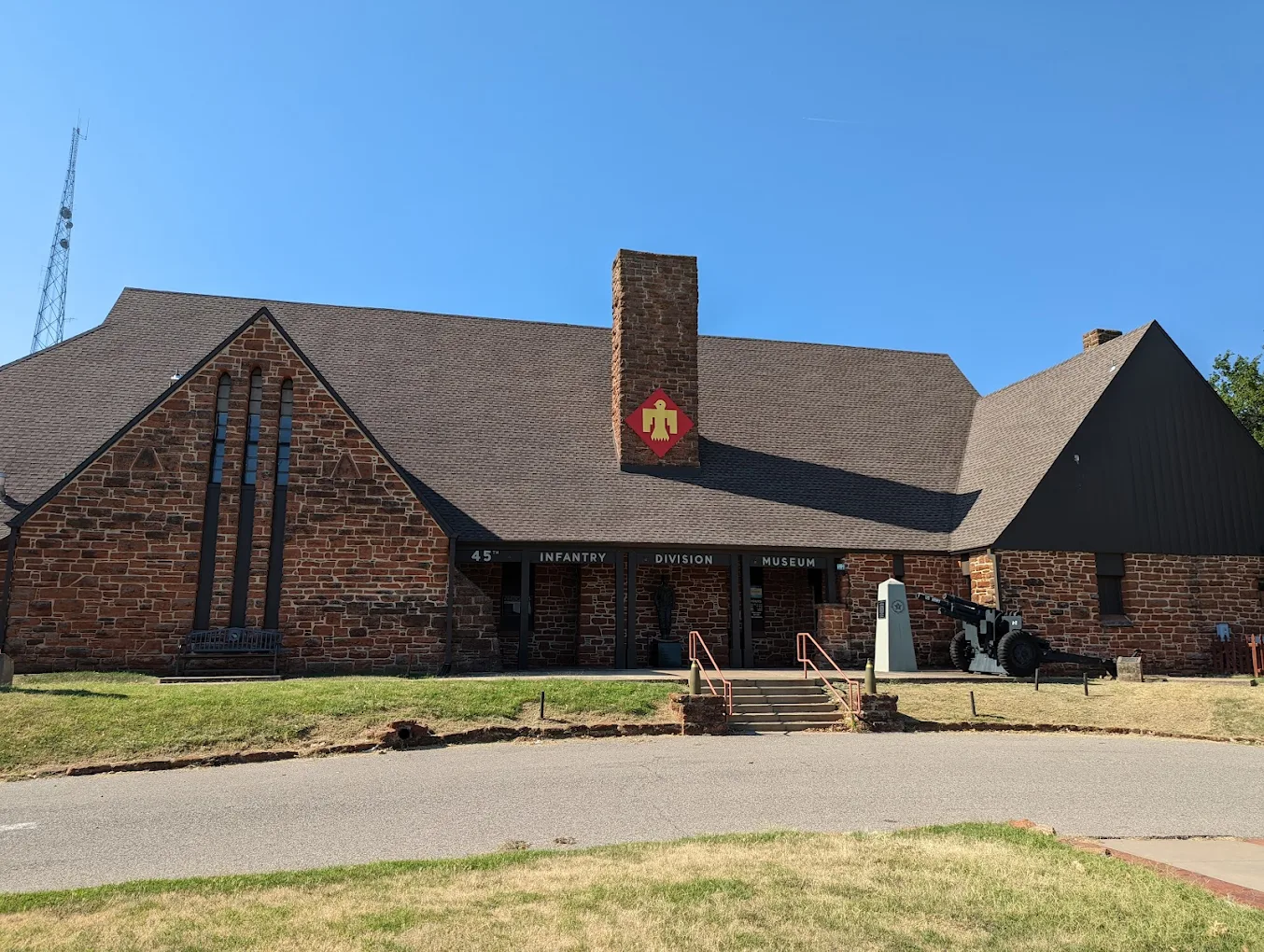

The Oklahoma National Guard Museum hosted a closing ceremony earlier this summer to honor its historic home, marking the end of an era for the 1937 Works Progress Administration building that served as a cornerstone in preserving the legacy of the Oklahoma National Guard and its service members.
During the 2021 legislative session, the Oklahoma Legislature approved changing the name of the Museum from the 45th Infantry Division Museum located at 2145 NE 36th Street in Oklahoma City to the Oklahoma National Guard Museum and raising funds to house a new museum building to serve as a home for the newly refocused Oklahoma National Guard Museum.
As the current museum focuses heavily on the 45th Infantry Division’s service during World War II, the new Oklahoma National Guard Museum will focus on telling the entire story of the Oklahoma Air and Army National Guard, from pre-statehood to modern times.
The museum will soon transition to a new state-of-the-art, nearly 40,000 square-foot facility located at 3301 Northeast Grand Blvd., is scheduled to open the summer 2026.
“The construction is going very rapidly actually. The building is enclosed. Sheet rock has gone up and we are still on target to open in the summer of 2026,” Dr. Denise Neil, the museum’s executive director said. “We closed the previous museum in May.”
It will provide enhanced space and tools to effectively tell the Oklahoma National Guard’s story from its founding through modern times, including a focus on domestic operations throughout the state and neighboring states.
“To be able to share and preserve and maintain a history of the men and women that serve in the National Guard in Oklahoma is really important that it drives our mission,” Neil said. “When we think about us starting with military history and how the Guard participated in wars, that starts really for us in 1898 with Guardsmen that leave the Guard to serve in the volunteers for the Spanish-American War. And that is history that people don’t know about because it’s so far removed.”
In addition to new displays, numerous artifacts from the 45th Infantry Division Museum will continue to be on display. There will also be a variety of interactive displays, which will provide more information about Oklahoma National Guard activities than is currently possible.
The museum has been instrumental in collecting, preserving, and interpreting the history of the Oklahoma National Guard. Its extensive collection includes the Jordan B. Reaves American Military Weapons Collection, Bill Mauldin’s personal collection of World War II cartoons, a tribute exhibit to the 12 members of the 45th Infantry Division and Oklahoma Army National Guard who received the Medal of Honor, a robust exhibit on the 45th ID’s role in the liberating the Dachau concentration camp 80 years ago, and more.
“All of the exhibitions will be brand new,” Neil said. “We will expand our storyline so we’re starting with the history of the Oklahoma National Guard beginning in 1890 with the establishment of the territorial militia and moving up as contemporary as possible. We also are expanding beyond telling the story of war so that we can tell the story of how the Guard responds to natural and man-made disasters in the state and the country as well. We’re also expanding how we tell the story of the Oklahoma Air National Guard in the new museum. And we’ve been pretty Army-heavy over here for a long time in the old museum, so we’re looking forward to that too.”
Though a bittersweet farewell to the building that housed the museum for nearly 50 years, Neil expressed gratitude and excitement for the future.
“My first job here was in the early 2000s, and then, fast forward to having the honor of guiding the museum to this new chapter,” Neil said. “The idea was that we needed a new building to house the museum’s collection so that we could tell a better story of the Oklahoma National Guard. We love our historic building, and it has great history to the [Oklahoma National] Guard, but it also has challenges, and a new building will allow us to do a better job.”
Neil said the Oklahoma National Guard and the Oklahoma Military Department intend to maintain their former building.
“The exact use in the future is to be determined, but they’re hoping that they will be able to take off the additions that we’re put onto it and turn it back to how it looked in 1937,” she said. “It’s a beautiful building and we’re sure glad they’re going to maintain it.”
Neil said the museum’s collections will start moving to its new site early next year.
“Everything is in the same building for right now. We will start moving collections toward January,” she said. We have relocated several sizable items from the park to another area. We are not taking everything out of the park. Some stuff will be maintained on the current property.”
Neil said the museum continues to attract visitors from Oklahoma and abroad.
“Our visitor numbers are good, and we look forward to them going up in the new space,” she said. “Most of our visitors are from Oklahoma. But on an average year, it’s not uncommon for us to have representation from foreign countries at all including from Germany and France. We aim to attract a broad international audience, as we believe our story is both compelling and worthy of attention.”
Neil said she wants visitors to the new museum to walk away with a better understanding of the role the Oklahoma National has played in the state’s past, present and future.
“I think my overarching message would be that we want people to come and learn about everything the Guard has done through its existence from pre-statehood days to current, and the impact that they have on the lives of Oklahomans to their service to community,” she said.
For more information about the Oklahoma National Guard Museum visit www.okngmuseum.com or scan the QR code. •
story by Van Mitchell, staff writer


